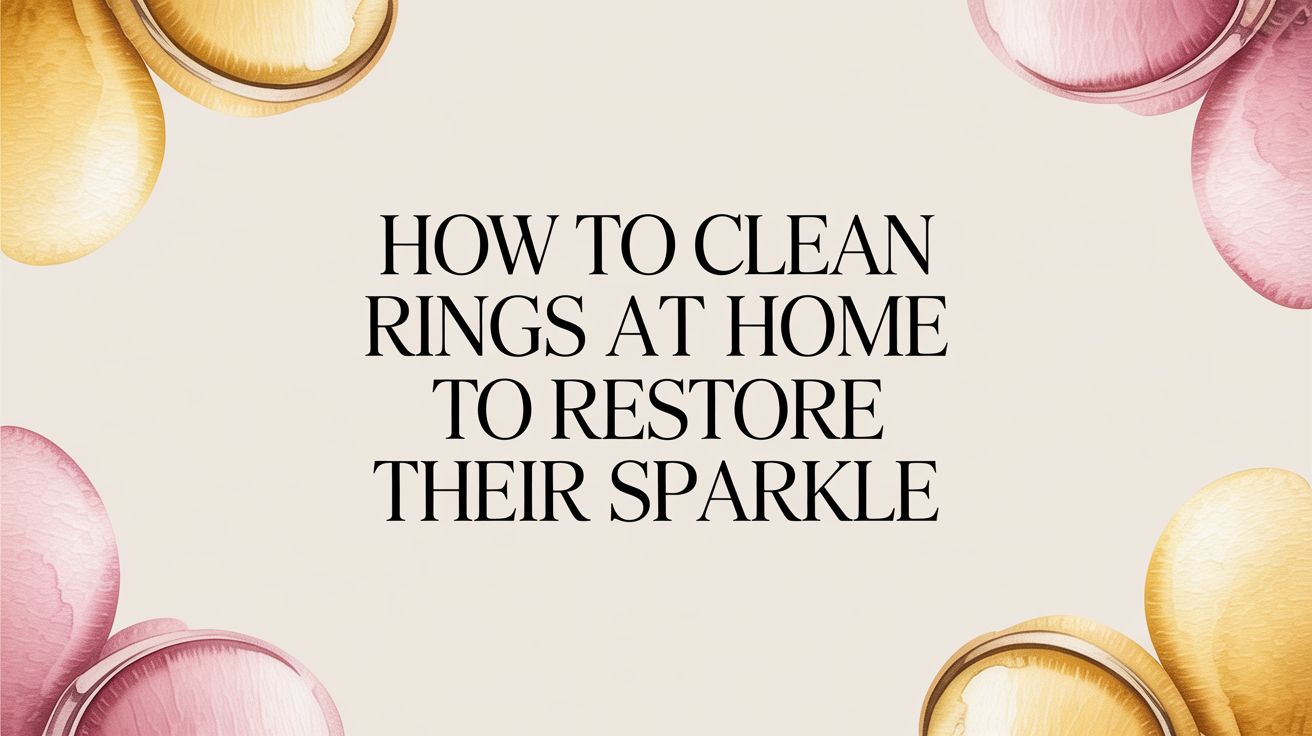The easiest and most trusted way to clean a durable ring at home is with a simple soak in warm water with a few drops of mild dish soap. Follow that with a gentle scrub using a soft-bristled toothbrush, and you're done. This method is perfect for bringing back the sparkle to solid gold, platinum, and diamond rings without risking any damage.
Your Quick Guide to Sparkling Rings at Home
Before you dive in, it’s crucial to remember that not all rings are created equal. The metal of your band and the type of gemstone it holds completely dictate the safest way to clean it. While that classic soap-and-water trick is a brilliant go-to for hard-wearing pieces, more delicate materials need a much gentler touch.
This quick guide is designed to give you an immediate "how-to" for the most common rings we see, so you can tackle daily grime with confidence. Knowing the right technique is the key to preventing accidental damage, like scratching a soft metal or discolouring a porous gemstone. It's all about matching the solution to the specific needs of your treasured jewellery.
Choosing the Right Method
The first step is always identification. Take a moment to really look at your ring. Is it solid gold, silver, or platinum? Is the stone a tough diamond or something softer, like an opal or pearl? Answering these questions helps you sidestep common mistakes, like using an abrasive cleaner on a plated finish or soaking a porous stone that could absorb chemicals.
This infographic gives a good overview of the recommended soaking times for different ring materials.
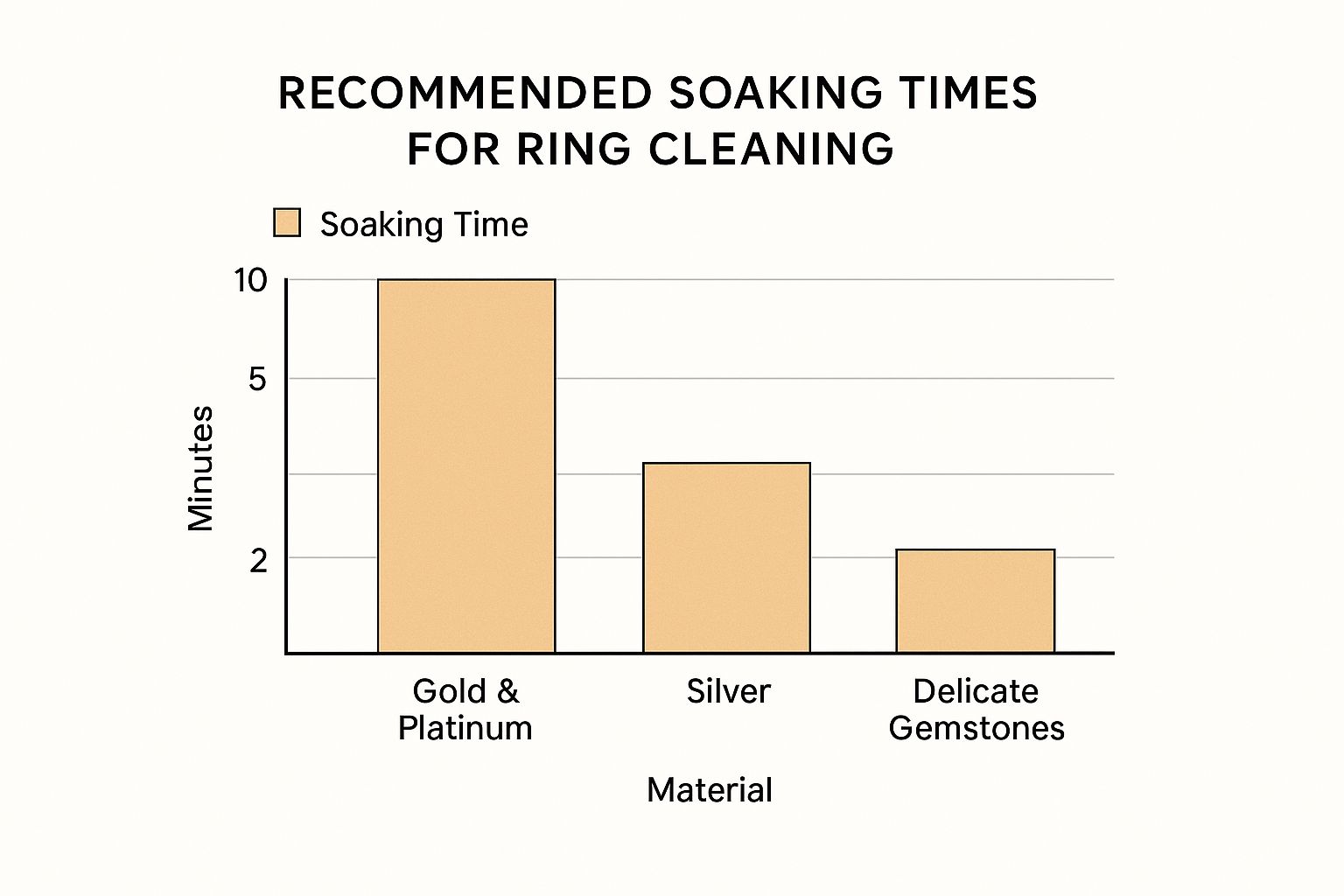
As you can see, robust metals like gold can handle a longer soak to loosen stubborn residue, whereas delicate gems just need a quick dip.
Embracing At-Home Care
It's no surprise that convenient and effective home cleaning is becoming more popular. Here in the United Kingdom, we've seen significant growth in people adopting at-home jewellery care routines. In fact, sales of specialised cleaning kits for gold, silver, and gemstone rings grew by 22% year-on-year, which really highlights the demand for safe, do-it-yourself solutions. You can actually learn more about these jewellery cleaner market trends and see how the industry is shifting.
Gathering Your Simple Cleaning Toolkit
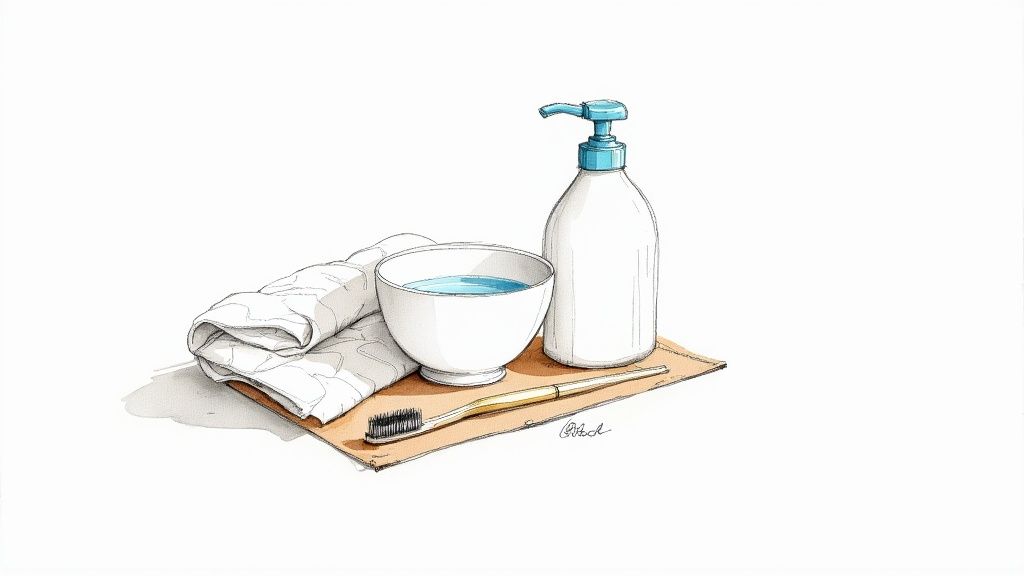
You don't need a professional workshop to bring back your ring's sparkle. In fact, pretty much everything you need for a safe and effective clean is probably already in your kitchen or bathroom cupboards.
The whole point is to gently lift away the daily build-up of lotions, oils, and general grime without using harsh chemicals or anything abrasive that could damage your treasured pieces. A little prep goes a long way, so it’s always a good idea to get your bits and pieces together before you start. It makes the whole process smoother and, more importantly, safer for your jewellery.
Your Essential Cleaning Supplies
The tools for the job are surprisingly simple. Each one has a specific role, helping to restore that lustre while protecting the metal and any gemstones.
Here’s what you’ll want to have on hand:
- A small bowl. This is for your cleaning solution. Please, never clean your jewellery directly over an open plughole—it’s a simple habit that prevents that heart-stopping moment when a ring slips.
- Mild, detergent-free dish soap. This is perfect for creating a gentle soak. It works wonders at breaking down the oils and grime without being corrosive to the metal.
- A soft-bristled toothbrush. One made for a baby is ideal. The bristles are gentle enough for soft metals like gold but effective enough to get into all those tiny crevices around the setting without scratching anything.
- A lint-free microfibre cloth. This is non-negotiable for drying and polishing. Paper towels or tissues can leave behind tiny fibres and even cause micro-scratches, whereas a good microfibre cloth gives you a brilliant, streak-free finish.
By choosing the right tools, you stay in complete control. A baby toothbrush, for example, gives you the precision to clean around delicate prongs without applying too much pressure—that’s key for keeping your gemstones secure in their setting.
With this simple toolkit ready, you’re all set to tackle the everyday dullness and bring back your ring's brilliant shine.
The Classic Method for Gold and Platinum Rings
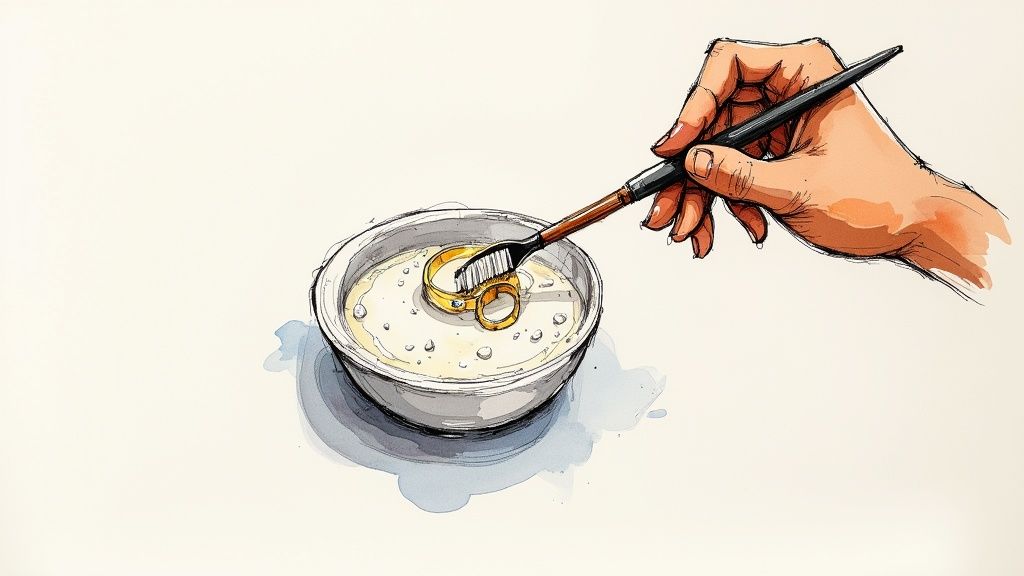
Gold and platinum are famous for their durability, but even the toughest metals can lose their edge. Everyday life—hand lotions, soaps, even the natural oils from your skin—builds up a dull film over time, hiding the brilliant shine you fell in love with.
Thankfully, you don't need harsh chemicals to bring that sparkle back. The time-tested method of using simple soap and water is easily the safest and most effective way to clean these precious metals. It's especially gentle on rings with detailed settings or precious stones like diamonds, lifting away the grime without putting your jewellery at risk.
Creating the Perfect Gentle Soak
First, let's prepare a simple cleaning bath. All you need is a small bowl of warm water. Be careful not to make it too hot, as extreme temperatures can cause thermal shock, which might loosen stone settings over time.
Add a couple of drops of mild, detergent-free dish soap, and give it a quick swirl to create some light suds.
Now, place your gold or platinum ring in the bowl and just let it be. Patience is key here—give it a good 20 to 30 minutes to soak. This step does all the hard work for you, gently softening and loosening the layers of built-up dirt and oil so you don't have to scrub aggressively later.
The Gentle Scrub and Final Polish
Once your ring has had a good soak, it’s time for a very light scrub. Take a super soft-bristled toothbrush (a baby toothbrush is ideal) and gently brush the ring. Pay a bit of extra attention to the tricky spots where grime loves to hide, like behind the main setting or inside any intricate metalwork. The idea is just to dislodge the softened residue, not scour the metal.
The real secret to cleaning around delicate settings is to use soft, circular motions. Avoid forceful back-and-forth scrubbing. This approach cleans the crevices perfectly while minimising any pressure on the prongs holding your gemstones in place.
After scrubbing, rinse the ring thoroughly under warm running water. A smart move is to either plug the sink or place your ring in a small sieve to avoid any heart-stopping moments over the drain.
Finally, pat it dry with a clean, lint-free microfibre cloth. Steer clear of paper towels; they can leave behind tiny fibres and even cause micro-scratches. A gentle pat dry, followed by letting it air dry completely, prevents water spots and brings out that brilliant, professional-looking shine.
If you notice deeper scuffs and scratches that this process won't remove, you might want to consider professional jewellery polishing services to truly restore its original, flawless finish.
Special Care for Silver and Delicate Gemstones
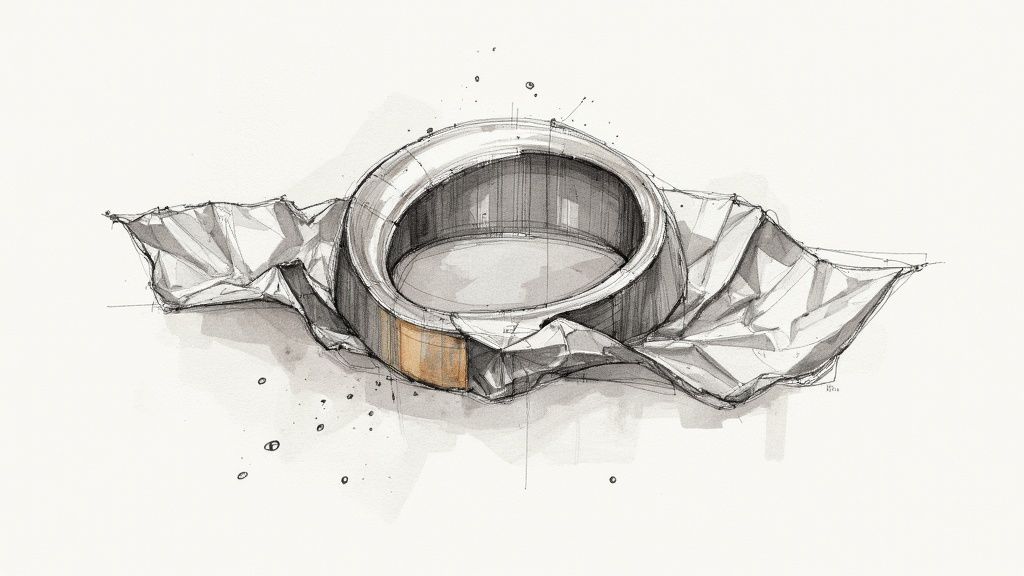
While the soap-and-water method is brilliant for durable metals like gold and platinum, it's definitely not a universal fix. Silver tarnishes, and many popular gemstones are far too delicate for a long soak or a vigorous scrub. Knowing how to handle these specific rings at home requires a more specialised touch.
Using the wrong method on these pieces can cause irreversible damage. A harsh polish can strip silver, while simple soap can permanently cloud porous stones like opals or pearls. This is where a little extra know-how goes a long way in preserving the beauty and value of your most delicate rings.
A Gentle Fix for Tarnished Silver
When silver reacts with sulphur in the air, it develops that familiar dark layer of tarnish. While it looks unsightly, you can lift it off without resorting to abrasive creams or cloths that can actually scratch the metal's surface.
A fantastic at-home method uses a simple chemical reaction. Just line a small bowl with aluminium foil (shiny side up) and add a tablespoon of baking soda. Pour in enough hot water to dissolve it, then place your silver ring inside, making sure it touches the foil.
Let it sit for a few minutes. You'll literally see the tarnish transfer from the ring to the foil. All you need to do then is rinse it with cool water and dry it with a soft, lint-free cloth.
This gentle process works through an electrochemical reaction where the tarnish (silver sulphide) is converted back into silver. It’s a much safer alternative to old-school polishing, which physically scrapes away a tiny layer of the metal along with the tarnish.
Protecting Your Precious Gemstones
The key to cleaning gemstone rings is understanding their hardness and porosity. A hardy diamond can withstand cleaning methods that would ruin a soft, porous stone like a pearl or an emerald.
Here’s a quick guide for some popular but delicate gems:
- Pearls, Opals, and Turquoise: These are extremely porous and soft. Never submerge them in water or use any kind of soap. Simply wipe them gently with a soft, damp cloth after each wear to remove skin oils.
- Emeralds: While relatively hard, emeralds are often treated with oils to fill in natural fractures. Soaking them or using an ultrasonic cleaner can strip these oils, making the stone look cloudy and even brittle. A quick wipe with a damp cloth is best, or a very quick dip in cool, soapy water followed by an immediate rinse.
- Tanzanite and Amethyst: These stones are more durable but can be sensitive to sudden temperature changes. Always use warm—not hot—water and a very soft brush.
If a stone becomes loose or you notice any cloudiness that just won't lift, it's always best to bring it to a professional. Damaged stones often require expert attention, and there are specialised gemstone replacement services available to restore your ring to its former glory.
Common Cleaning Mistakes You Must Avoid
Knowing how to properly clean your rings at home is as much about what not to do as it is about what you should. Some seemingly harmless household items can cause irreversible damage to your treasured jewellery, turning a quick clean-up into a costly mistake.
It's tempting to reach for whatever you have under the sink, but this can be disastrous. Harsh chemicals are the main culprits.
- Bleach and Chlorine: These are particularly nasty to metals. They can react with gold, causing it to discolour and, over time, become brittle and weak.
- Acetone: While it’s brilliant for nail polish, it can easily break down the finish on certain gemstones and damage the adhesive in some settings.
And please, ignore the old myth about toothpaste. It’s full of tiny abrasives designed to scrub teeth, not precious metals. Using it will leave permanent micro-scratches all over soft metals like gold or platinum, dulling their shine forever.
The Hidden Dangers of Ultrasonic Cleaners
While those professional-looking ultrasonic cleaners might seem like a shortcut to a perfect sparkle, they pose a serious risk to certain types of rings. These machines work by sending powerful vibrations through a cleaning solution to shake dirt loose.
That vigorous action can be far too much for delicate gemstones like emeralds, opals, or tanzanite, which often have natural inclusions or fractures inside. The vibrations can easily cause these stones to crack or even shatter. What’s more, if any of your ring's prongs are even slightly loose, those vibrations can shake the stone right out of its setting. It's much safer to stick with manual methods for these precious pieces.
Ring Cleaning: Your Questions Answered
Even with a good guide, it's natural to have a few questions before you start cleaning a piece of jewellery that means the world to you. Getting the right advice is key to feeling confident you’re doing the best thing for your ring.
Here are our answers to the questions we hear most often from clients.
How Often Should I Clean My Engagement Ring?
For a ring you wear every day, a light clean once a week is a fantastic habit to get into. This quick wash-up with mild soap and warm water stops daily grime like hand lotion, makeup, and skin oils from building up and hardening.
Once or twice a month, set aside time for a more thorough soak and a gentle scrub. This little bit of regular care is what keeps your gemstones sparkling and prevents dirt from getting properly lodged in the setting, which is always much harder to shift later on.
Is It Safe to Use Boiling Water on My Diamond Ring?
Definitely not. While diamonds themselves are incredibly tough, boiling water poses a serious risk of thermal shock to the metal setting.
The sudden, extreme change in temperature can make the metal expand and contract far too quickly. This can easily loosen the prongs holding your stone, creating a very real risk of it falling out. It's always much safer to stick to warm, not boiling, water.
Can I Use a Store-Bought Jewellery Dip?
Those commercial jewellery dips can give you a brilliant shine, but you have to be careful. Many of them contain powerful chemicals that can cause real damage to softer or porous gemstones—think pearls, opals, emeralds, and turquoise.
They can also strip the delicate plating from some metals. Before you even think about using one, read the label very carefully to be sure it’s safe for your ring's specific materials. When in doubt, the simple soap and water method is always the safest bet. If you're dealing with stubborn tarnish or dirt, professional jewellery cleaning services are your best option.
At Opulence Jewellery Services, our Hatton Garden workshop provides expert cleaning and repairs to restore your jewellery's original beauty. Visit us for a professional clean and inspection.
